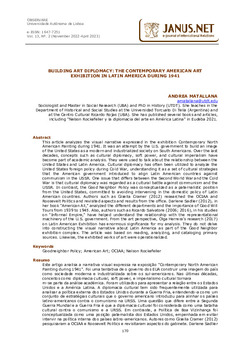| dc.rights.license | https://creativecommons.org/licenses/by-sa/2.5/ar/ | es_AR |
| dc.contributor.author | Matallana, Andrea | es_AR |
| dc.date.accessioned | 2022-11-29T18:07:53Z | |
| dc.date.available | 2022-11-29T18:07:53Z | |
| dc.date.issued | 2022 | |
| dc.identifier.citation | Matallana, Andrea (2022). Building Art diplomacy: the Contemporary American Art Exhibition
in Latin America during 1941. Janus.net, e-journal of international relations, Vol13 N2,
November 2022-April 2023. Consulted [online] in date of last visit,
https://doi.org/10.26619/1647-7251.13.2.6 | |
| dc.identifier.issn | 1647-7251 | |
| dc.identifier.uri | https://repositorio.utdt.edu/handle/20.500.13098/11466 | |
| dc.identifier.uri | https://doi.org/10.26619/1647-7251.13.2.6 | |
| dc.description.abstract | This article analyzes the visual narrative expressed in the exhibition Contemporary North American Painting during 1941. It was an attempt by the U.S. government to build an image of the United States as a modern and industrialized society on South Americans. Over the last decades, concepts such as cultural diplomacy, soft power, and cultural imperialism have become part of academic analysis. They were used to talk about the relationship between the United States and Latin America. Cultural diplomacy has often been utilized to analyze the United States foreign policy during Cold War, understanding it as a set of cultural strategies that the American government introduced to align Latin American countries against communism in the USSR. One issue that differs between the Second World War and the Cold War is that cultural diplomacy was regarded as a cultural battle against communism and the USSR. In contrast, the Good Neighbor Policy was conceptualized as a paternalistic position from the United States, committed to avoiding intervening in the domestic policy of Latin American countries. Authors such as Gisella Cramer (2012) researched the OCIAA and Roosevelt Politics and revisited aspects and results from the office. Darlene Sadlier (2012), in her book "American All," analyzed the different departments and the importance of Good Will Tours from 1939 to 1945. Also, authors such as Ricardo Salvatore (2006; 2016), in his studies on "Informal Empire," have helped understand the relationship with the representational machinery of the U.S. government. From the art perspective, Olga Herrera's research (2017) on Latin American Exhibition has enormous significance for my analysis. They do not delve into constructing the visual narrative about Latin America as part of the Good Neighbor exhibition complex. The article was based on reading, analyzing, and cataloging primary sources. Likewise, the exhibited works of art were operationalized. | es_AR |
| dc.description.sponsorship | JANUS.NET | |
| dc.format.extent | p.169-186 | es_AR |
| dc.format.medium | application/pdf | es_AR |
| dc.language | spa | es_AR |
| dc.publisher | OBERVARE. Universidade Autónoma de Lisboa | es_AR |
| dc.relation.ispartof | Janus.net, e-journal of international relations, Vol13 N2,
November 2022-April 2023 | |
| dc.rights | info:eu-repo/semantics/openAccess | es_AR |
| dc.subject | Goodneighbor Policy | es_AR |
| dc.subject | American Art | es_AR |
| dc.title | Building Art diplomacy: the Contemporary American Art Exhibition in Latin America during 1941 | es_AR |
| dc.type | info:eu-repo/semantics/article | es_AR |
| dc.subject.person | Nelson Rockefeller | es_AR |
| dc.subject.keyword | OCIAA | es_AR |
| dc.type.version | info:eu-repo/semantics/publishedVersion | es_AR |

